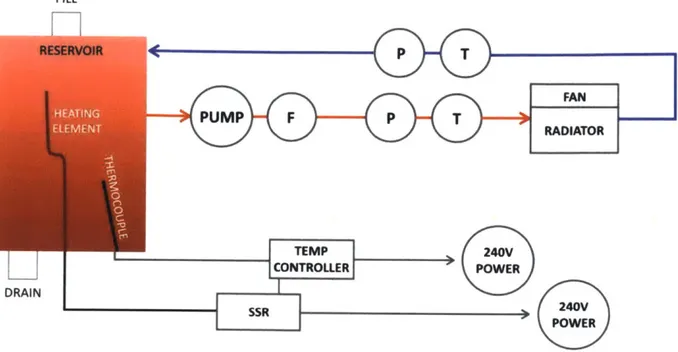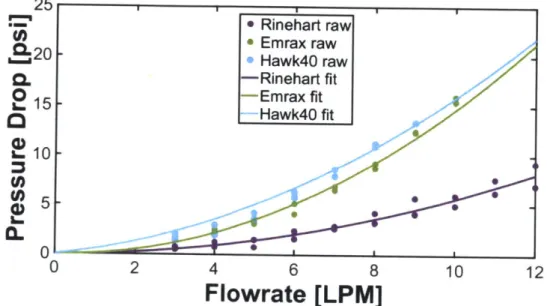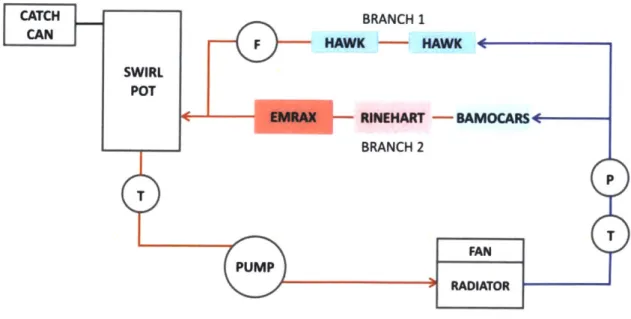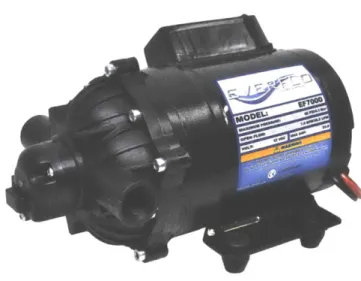Design of a FSAE Cooling System
by
Harriet Alicia Chiu
MASSACHUSETTS INSTITUTE
Of
TECHNOLOGYJul- 16
2019
LIBRARIES
Submitted to the
ARCHIVES
Department of Mechanical Engineering
in Partial Fulfillment of the Requirements for the Degree of
Bachelor of Science in Mechanical Engineering
at the
Massachusetts Institute of Technology
June 2019
2019 Massachusetts Institute of Technology. All rights reserved.
Signature redacted
Signature of Author:Department of Mechanical Engineering May 16, 2019
Signature redacted
Certified by:lrmgarcBischlfberger Assistant Professor of Mechanical Engineering
Signature redacted
Thesis Supervisor Accepted by:Maria Yang Professor of Mechanical Engineering Undergraduate Officer
Design of a FSAE Cooling System
by
Harriet Chiu
Submitted to the Department of Mechanical Engineering on May 16, 2019 in Partial Fulfillment of the
Requirements for the Degree of
Bachelor of Science in Mechanical Engineering
ABSTRACT
MIT Motorsports is a FSAE Electric team at MIT that designs, manufactures, and tests electric formula-style racecars to compete in an annual collegiate competition. The cooling system for the Model Year 19 vehicle must provide adequate cooling to the motors and motor controllers, meet power consumption requirements dictated by the low voltage battery, and minimize system mass. Fluid modelling and benchtop testing were used to select the most suitable pump, fan and radiator. Tube routing and mounting design also have to allow for serviceability. With the use of a cooling test bench, a flow architecture was developed, and components were modified and tested to meet specifications.
Thesis Supervisor: Irmgard Bischofberger
ACKNOWLEDGEMENTS
This thesis is dedicated to MIT Motorsports. Special thanks to Serena Grown-Haeberli for her leadership of team and moral support, Jeremy Noel for his help every step of the way, Ethan Perrin for the construction of the cooling bench, Ash Demir for her thermal and fluids wisdom and battery room shenanigans, Zoe Levitt for her help with running tests on cooling bench, Cheyenne Hua for her harnesses, Audrey Gaither for her help with assembly, and Alex Hattori for his help with frankenpump. I would also like to thank alumni of the team who have worked on the cooling system in the past, including Elliot Owen and Luis Mora.
Thanks to Irmgard Bischofberger for being a wonderful thesis advisor, and for her thoughtful comments on this paper.
TABLE OF CONTENTS
A B S T R A C T ... 2
ACKNOW LEDGEM ENTS ... 3
TABLE OF CONTENTS ... 4
LIST O F F IG U R E S ... 5
LIST O F T A B LE S ... 5
1 . IN T R O D U C T IO N ... 6
1.1 FORM ULA SAE AND M IT M OTORSPORTS ... 6
2 . B A C K G R O U N D ... 7
2.1 INTRODUCTION TO COOLING SYSTEM ... 7
2.2 SYSTEM REQUIREM ENTS ... 8
3 . D E S IG N ... 9
3 .1 SY ST E M IN P U T S ... 9
3.2 COOLING SYSTEM EQUATIONS ... 10
3.3 PRESSURE DROP TESTING ... 10
3.4 ARCHITECTURE ... 12
3.5 COOLING COM PONENTS ... 13
P U M P ... 1 3 RADIATOR AND FAN ... 16
S W IR L P O T ... 1 8 C A D ... 2 0 4. SYSTEM PERFORM ANCE ... 21
5. CONCLUSIONS AND FUTURE W ORK ... 22
A P P E N D IX ... 2 3 R E F E R E N C E S ... 2 4
LIST OF FIGURES
Figure 1: Force vs time graph for all-wheel drive 6
Figure 2: Powertrain architecture for MY19 7
Figure 3: Rinehart temperature data from MY18 endurance 8
Figures 4a and 4b: Emrax (a) and Hawk 40 (b) efficiency maps. 9
Figure 5: Block diagram of cooling test bench 11
Figure 6: Cooling test bench setup 11
Figure 7: Pressure drop of Rinehart, Emrax and Hawk 40 motors with varying flowrates 12
Figure 8: Parallel flow architecture 13
Figure 9: Everflo Diaphragm Pump Model EF7000 14
Figure 10: The prototype pump 15
Figure 11a and 11b: Frankenpump flowrate test setup and flowmeter 15
Figure 12: Total pressure drop across radiator 17
Figure 13: Fan curves with radiator pressure drop 17
Figure 14: Radiator and fan shroud assembly 18
Figure 15a and 15b: Swirl pot features 18
Figure 16: Solidworks Flow Simulation flow trajectory 19
Figure 17: CAD of cooling system 20
Figure 18: MY18 radiator and fan setup on the cooling test bench 21 Figure 19: Heat dissipation of various radiators and fans at different flowrates 22
LIST OF TABLES
Table 1: Component flowrate, water temperature and pressure limit requirements 9
Table 2: Minor loss coefficients 10
1. INTRODUCTION
1.1 FORMULA SAE AND MIT MOTORSPORTS
MIT Motorsports is a Formula SAE Electric team that competes in the Formula SAE collegiate competition annually. Teams design, manufacture, test and race a formula-style racecar, and are judged based on design, cost and track performance of the vehicle. The model year 17 (MY17) and model year 18 (MY18) vehicles of MIT Motorsports have the same architecture, with rear-wheel drive and a custom air-cooled battery pack. MY17 won second place overall at the 2017 competition, while MY18 achieved the fastest acceleration, autocross and endurance times at the 2018 competition.
With two model years of electrically and mechanically reliable rear-wheel drive vehicles, the team decided to take on the challenge of building our first all-wheel drive vehicle for MY19. This decision was informed by simulations that proved that adding front motors decreased acceleration time from 4.02 sec to 3.75 sec for a 306 kg car. This is because from a power perspective, an all-wheel drive car is limited by friction at the tires and the 80kW power limit on both front and rear wheels, as opposed to tractive power from the motors, as shown in Figure 1.
7000 --_ Tire r 6000 Power Limit r Tractive r Tire f 5000 Tractive f Power Limit f j 4000 L3000 2000 1000 0 0.5 1 1.5 2 2.5 3 3.5 4 4.5 5 Time(s)
Figure 1: Force vs time graph of the resultant forces of the 3 sources of power at the front (f) and rear (r) wheels during acceleration - tire friction, tractive power and the 80kW power limit. In all-wheel drive, both front and rear powertrains are limited by friction of the tires, and then by the
80kW power limit imposed by FSAE rules.
Moving to all-wheel drive means that the cooling system has to cool more motors and motor
controllers. A new flow architecture was determined through analytical modelling and empirical testing. On the component level, cooling components were tested for performance and optimized for mass.
2. BACKGROUND
2.1 INTRODUCTION TO COOLING SYSTEM
The cooling system on an electric formula-style vehicle water cools the motors and motor controllers. The rear powertrain on MY18 consists of the Emrax 228 motor, and the Rinehart PM100 motor controller. On the MY19 vehicle, the rear powertrain maintains the same architecture with the Emrax and Rinehart. For the front powertrain, two Hawk 40 motors were selected and they would be paired with Bamocar D3 motor controllers, as shown in Figure 2. A custom enclosure was designed for the Bamocars, with custom cold plates that meet the heat dissipation requirements.
FRONT
HAWK
HAWK BAMOCARS RINEHART EMRAX REARFigure 2: Powertrain architecture of MY19 showing the two Hawk motors in the front wheel packages, the Emrax motor in the rear. The Bamocar and Rinehart motor controllers are connected to the motors as shown.
2.2 SYSTEM REQUIREMENTS
The MY18 cooling system was able to adequately cool the Emrax and Rinehart. Rinehart temperature sensor data from the endurance event at competition showed that internal temperatures of the Rinehart peaked at 59.2'C, as seen in Figure 3. The maximum allowable temperature of 80'C was never exceeded.
60 -Gate -Module A 55 , Module B -Module C 50 45L &40 E 35 30 250 0 10 20 30 40 50 Time (min)
Figure 3: Rinehart temperature data from built-in sensors at the gate and at 3 points in the internal modules. The drops in temperature from minute 10 to 23 and from minute 30 onwards are due to limp mode, which limits power output so that our battery does not overheat.
The main issues with MY18's cooling system were identified to be:
1. Lack of optimization, resulting in heavy system mass. The 3.17 kg diaphragm pump contributed the majority of the cooling system mass.
2. Poor packaging of components meant that mounting of the swirl pot, pump and radiator and fan assembly were difficult to access.
MY19's cooling system seeks to improve upon MY18's and meet the system level requirements of: 1. Providing adequate cooling to the critical components
2. Operating reliably without leaks, contaminants or excessive air in the tubes 3. Designing a well packaged system and stiff mounting
4. Meeting power consumptions requirements 5. Limiting impact on aerodynamics of the vehicle
3. DESIGN
3.1 SYSTEM INPUTS
The motor and motor controller manufacturers provide guidelines that the components should operate at, as summarized in Table 1.
Table 1: Flowrate, water temperature and pressure limit requirements of the Rinehart, Emrax, Bamocar and Hawk 40 motors as specified by their respective manufacturers [1],[2],[3],[4]. The minimum flowrate across components is 7 to 8 LPM, and the maximum is 12 LPM.
Minimum Flowrate Maximum Flowrate Maximum Water Temp Pressure Limit
[LPM] [LPM]
[C]
[bar]Rinehart 8 12 80
-Emrax 7 - 50 2
Bamocar - 65
-Hawk 40 7.5 12 47
-Motor and motor controller efficiencies were used to determine the required power dissipation of the cooling system. The Rinehart has a minimum efficiency of 97% (erinehart), the Emrax 92% (eemrax),the
Bamocars 92% (ebamo), and the Hawks 92%
(ehawk)-HAWK40 -320V
EMRAX 228 High Voltage CC Efficiency map - e ...---..--- - 80 Efficiency Map 90 -94 % 70.---- 50 90 94 % 60. 85 40 80 -95 % Z 5 S40 -30- 70 3-% 9-20 -55 1005 86- 90% 00 L4 2M isW 2M 2SW m 35
Figures 4a and 4b: Emrax (a) and Hawk 40 (b) efficiency maps. 92% efficiency for both components were chosen to be the worst case scenario given our operating points [2],[4].
MY18 had an average power draw of 30 kW, which meant that the cooling system dissipated 3.2 kW in its worst case. We estimate that MY19 would have a similar average power draw of 30kW. Through simulations that take into account tractive power, power from the tires and the power limit of 80kW, the optimal power split of 24.12% front (sfront) and 75.88% rear (srear) was determined. Using equations (1) and (2), the power from the inefficiencies in the front and rear powertrain can be calculated.
Pdissipated,front = 30kW X Sfront X
(1
- ebamo) + ebamo X (1 - ehawk)] ( 1)Pdissipated,rear = 30kW X srear X [(1 - erinehart) + erinehart X (1 - eemrax)] (2)
Assuming that all inefficiencies dissipate as heat, the MY19 cooling system will be required to dissipate 3.6 kW.
3.2 COOLING SYSTEM EQUATIONS
To determine the architecture of the cooling loop, an iterative model to solve for the flowrate given pressure drop was created.
The pressure drop across a pipe can be calculated by summing the major losses, minor losses and the pressure drop of large components, all in terms of flow velocity.
AP = APmajor(V) + APminor(v) + APcomponents(v) (3)
To calculate major losses, the Reynold's number (Re) and the Darcy friction factor (f) have to be calculated for a given flow velocity (v). Parameters required are the density (p) and dynamic viscosity (pt) of water, tube diameter (D) and roughness (E).
APmajor(V) = Ef L D 2 (4)
f = (-1.81g
~Re
+ D \3.7)J
(5)Re = pvD (6)
Minor losses can also be found given the minor loss coefficients (K factors), as shown in Table 2.
APminor (V) =
2
K P (7)2
Table 2: Minor loss coefficients (K factors) referenced from [1].
Type K factor
45' Bend 0.4
90' Bend 1.5
T branch inline 0.9 T branch 90' bend 2
3.3 PRESSURE DROP TESTING
The pressure drop functions of the large components had to be found empirically. This was achieved with the help of a custom cooling test bench. The cooling test bench has a 5 gallon tank, with a heating element equipped with a temperature controller. A flowmeter is installed in the loop to measure the flowrate the pump is operating at. Components can be connected to it using quick-disconnect fittings. Each end of the quick-disconnects have temperature sensors and pressure gauges, so that temperature drop and pressure drop can be recorded across components. Figures 5 and 6 show the block diagram and the setup of cooling test bench.
FILL RESERVOIR TEMP CONTROLLER DRAIN SSR 240V POWE 240V POWER
Figure 5: Block diagram of cooling test bench. Pressure sensors (P), temperature sensors (T), and
a flowmeter (F) are positioned before and after the radiator to monitor performance.
RESERVOIR APERATURE NTROLLER PRESSURE GAUGES
i~Od
COMPONENTS TO TEST FLOW METER -THERMOCOUPLE READERFigure 6: Cooling test bench setup. .1 t~ r~. -~ TE Cc P FAN
PUMP
F P TAIAO w vn Am vwThe Rinehart, Emrax and Hawk 40 motors were connected to the test bench, and their pressure drops were recorded over a range of 3 to 11 liters per minute (LPM). For zeroing purposes, the pressure drop of the cooling bench system, and the 1/2in to 3/8in fitting adapters were recorded as well.
The pressure drop (AP) versus flowrate (Q) curves were fit to a quadratic form of AP = AQ2 + BQ. The
data and their curve fits are shown in Figure 7. The Hawk 40 had the highest pressure drop while the Rinehart had the lowest pressure drop.
25
L20
am215
0
0 (A.15)
LM-CL
e Rinehart raw o Emrax raw * Hawk4O raw -Rinehart fit-Emrax fit
- Hawk4O fit SI-4
6
8
Flowrate [LPM]
10ON
0
2
12Figure 7: Pressure drop of Rinehart, Emrax and Hawk 40 motors with varying flowrates. All curves fit a quadratic form with an intercept at zero.
3.4 ARCHITECTURE
Knowing the pressure drop across the tube, components and fittings, different configurations of the cooling loop could be modelled. The process of iteration is as follows:
Determine which components to place in each branch Vary total pressure drop across the branch
Use Excel Goal Seek to solve for flow velocity and flowrate given a tube diameter of 3/8in Adjust the pressure drop such that the flowrate would be 7 to 8 LPM
Check if the pressure drop is reasonable for the pumps on the market.
The resulting architecture is as presented in Figure 8. The results from the iterative flowrate-pressure drop calculation are shown in Table 3.
F-1. 2. 3. 4. 5.SWIRL POT -F E T PUMP MRAX
Figure 8: Parallel flow architecture with two Hawks in branch 2. Pressure sensors (P), temperature sensors the loop to monitor performance.
CATCHCAN
branch 1; Bamocars, Rinehart and Emrax in (T), and flowmeter (F) can be integrated in
Table 3: Results from iterative flowrate-pressure drop calculation. Total flowrate is about 15 LPM
and pressure drop across branches is about 30 psi.
Velocity iterated AP Q Q
[m/s] [N/mA2] [mA3/s] [LPM]
Branch 1 1.88 200000 1.34E-04 8.06
Branch 2 1.83 200000 1.31E-04 7.84
Total 2.65E-04 15.89
The two Hawk 40s are in branch 1, while all other components are in branch 2. This is beneficial for routing as the front motors are in their own loop and can minimize tubing. The motor controllers are placed first in the branch 2, as they are more sensitive to temperature spikes. The pressure drop across the entire cooling loop including the radiator and fittings is about 40 psi.
3.5 COOLING COMPONENTS PUMP
On MY18, the cooling system used a diaphragm water pump, which although heavy, reliably provided adequate flowrate for the given pressure drop. For MY19, the goal was to reduce the mass without compromising performance.
Centrifugal and diaphragm pumps were considered for MY19. A centrifugal pump has a rotating impeller that accelerates the fluid. The fluid exits the pump at a higher velocity due to centrifugal force. A
BRANCH 1 HAWK - HAWK - RINEHART - BAMOCARS BRANCH 2 P T FAN RADIATOR
A'
centrifugal pump cannot be run dry and needs to be primed. A diaphragm pump is a positive displacement pump that uses expanding and contracting cavities to push the fluid. Unlike a centrifugal pump, a diaphragm pump can maintain constant flowrate at any discharge pressure. A diaphragm pump can further be run dry without damage. These benefits of a diaphragm pump led to the decision to use one for MY19.
Off the shelf diaphragm pumps were able to meet my pressure head requirement of 40 psi at 15 LPM.
However, these pumps have large brushed DC motors that contribute the majority of its heavy mass. Before a lower mass solution was found, a temporary pump, Everflo Diaphragm Pump Model EF7000, was chosen for the cooling system, and is shown in Figure 9.
Figure 9: Everflo Diaphragm Pump Model EF7000. At no load it can operate at 7.0 GPM (26.7 LPM).
It weighs 4.3 kg.
With no lighter diaphragm pumps on the market, in-house modification was required. A pump was disassembled, and its heavy brushed motor was replaced with a lighter brushless motor. The brushless motor used can provide maximum of 744 W of power, which provides a large margin for the 69 W power requirement from pressure drop and flowrate. However, the efficiency, torque and speed requirements of the pump could not be determined, so testing was needed to determine whether the motor was appropriate. The shaft in the brushless motor was replaced to match the coupling in the diaphragm. Figure 10 shows the brushless motor pump prototype.
Figure 10: The prototype pump, nicknamed "Frankenpump", with T-motor model MN5212 KV340.
The prototype was connected to a flowmeter, and maximum capacity, drawing about 120 W. Figure flowrate.
Figure 11a and 11b:
LPM.
it could achieve 11 LPM of flow with the motor at its
11a and 11b show the testing set up and resulting
Frankenpump flowrate test setup and flowmeter showing the flowrate of 11
To reach a flowrate of 15 LPM, the next step is to replace the KV340 brushless motor with the KV420 model, which has a maximum power of 1440 W and maximum RPM of 7440.
There is risk of mechanical failure in the diaphragm pump head, as it may not be designed to operate at high speeds. These risks will be mitigated through testing and inspecting for signs of wear. If this pump head fails, a more robust diaphragm pump head can be used.
RADIATOR AND FAN
To push enough air through the radiator, an appropriate fan has to be selected. Analytically, the airflow across the radiator can be modelled to obtain the pressure drop across the radiator, and can be plotted against the fan curve to estimate the operating point of the fan.
Pressure drop across the radiator can be modelled as sudden contraction as the air enters the fins, major losses as air travels through the fins and sudden expansion as air exits the radiator. Knowing the length (L) and width (W) of the radiator, the total area where the air enters (Ai,) the radiator can be found.
Ain = L - W (8)
The area of airflow through each fin channel (Achannel) can be measured and total area (Aout) can be estimated by counting the number of channels on the radiator (Nchannei).
Aout = Achannel -Nchannel (9)
Given a range of flowrates (Q), the flow velocity (vpipe) through the fin channels of the radiator can be calculated.
Vpipe - Ain ( 10)
Pressure drop from contraction and expansion can be calculated from the equations 11 and 12.
APcontract(vpipe) =
{Pair(Vpipe)
(Aout 1)2APexpand(vpipe) = - Pair .At( - Aout Vpipe2 (12) Pressure drop from major losses can be calculated using equations 4, 5, and 6. For diameter (D),
hydraulic diameter (Df) was used due to the irregular shape of the fin channels. The perimeter of the channels (Pchannel) was found through measurement.
Dh = 4
-Achannel
(13
Pchannel
The total pressure drop across the radiator is the sum of the calculated pressure drops above.
AP =
APcontract + APmajor + APexpand
(14)Figure 12 shows the total pressure drop across a Yamaha YFM700R raptor aluminum radiator that was used on MY19.
200
1
-* -ContractionC
150
. -Pipe
Flow
-- -Expansion10
-Total
0100--
50-0
50
--100,
0
2
4
6
8
10
Flowrate
[m3/min]
Figure 12: Total pressure drop across a Yamaha YFM700R raptor aluminum radiator. Pipe flow and contraction dominate the pressure drop.
Fan curves were then plotted together with the total pressure drop determined from the radiator model, as shown in Figure 13. These fan curves were obtained from manufacturer datasheets
[6],[7],[8],[9]. A range of fans were considered, including SPAL brand fans that are used in racing, and
computer fans from Sanyo Denki.
800
(U
-Radiator
C..
-120mm
Fan
-d600 -
-140mm
Fan
60
5.4in SPAL
0
LM -5.6in SPAL0
400-U)
U)
200-0
I-0
_
0
2
4
6
8
10
Flowrate
[m
3/min]
Figure 13: Fan curves from a 120mm and 140mm Sanyo Denki fans and 5.4in and 5.6 SPAL fans and the total radiator pressure drop. The 120mm, 5.4 in and 5.6in fans had operating points at around 6 to 7 M.
Since this pressure drop is purely analytical, further testing is required to determine fan performance. The 120mm and 140mm fans from Sanyo Denki were purchased for further testing, as they are lighter than the SPAL fans of comparable size.
An aluminum Mishimoto dirt bike radiator larger than the one on MY18 was modified with Earls fittings and tabs. A larger radiator was purchased for comparison purposes. The fan was connected to the
radiator by an aluminum shroud fitted with PEM inserts, shown in Figure 14.
Figure 14: Radiator and fan shroud assembly.
SWIRL POT
Once the flow goes through the motors and motor controllers, the branches merge and water enters the swirl pot. The swirl pot, shown in Figure 15, aims to reduce flow velocity through the diffuser, allows air to escape through vortexing and avoids introducing more air as the water leaves through the outlet.
Figure 15a and 15b: The inlet on the left leads water into the diffuser, and the water vortexes down to the outlet which connects to the pump. The inlet is offset from the center plane so that the flow can vortex down the cylinder.
The diffuser has a higher surface roughness to introduce turbulence such that air can escape. The fill neck at the top has a cap that is rated for 19 psi. If the pressure rises above 19 psi, fluid flows out into a catch can.
Flow simulations were attempted to determine where to place the fluid inlet - high up, midway or lower closer to the outlet. An inlet mass flow is applied, and the bottom outlet has the boundary condition of environmental pressure. Gravity is also modelled. The resulting flow trajectories are seen in Figure 16.
52703 2403 2103 1902 1502 1 201 0,901 0.501 0300 0 F~TrdouI6Sm I
z4
Figure 16: Solidworks Flow Simulation flow trajectory plots predict how water will vortex depending on the location of the fluid inlet.
It was difficult to interpret the behavior of cavitation in the flow simulation, so the design was chosen intuitively. The diffuser was placed in the middle configuration, so that water will be less likely to spill out the fill neck but still allow for sufficient swirling.
CAD
Full system CAD and routing was integrated into the car CAD. Figure 17 shows the cooling system components with the front and rear powertrain.
C'
Figure 17: CAD of cooling system on frame with front and rear powertrain.
4. SYSTEM PERFORMANCE
The radiator and fan from MY18 was placed on the cooling test bench to evaluate the amount of heat dissipated. Temperature readings were taken at the inlet (Tin) and outlet (Tout) of the radiator at varying flowrates (?ft), with the fan operation at its maximum speed. Figure 18 shows the experimental setup.
MY18 RADIATOR
AND FAN
POWER SUPPLY FOR FAN
Figure 18: MY18 radiator and fan across the radiator
setup on the cooling test bench to measure temperature drop
Heat dissipation was calculated using equation 15, using the specific heat capacity of water (cy) at the average water temperature.
Q
= ricp (Tin - Tout) (15)The larger radiator and fans chosen for MY19 were also tested. Figure 19 shows the heat dissipated by MY18's radiator and fan, and the MY19 radiator with the stronger as 140mm fan, and with weaker 120mm fan.
1 - MY18 - MY19 120mm 0.-- MY19 140mm 0.8 - 0.4-CD .2.0.2 -2 3 4 5 6 7 8 9 10 11
Flowrate [LPM]
Figure 19: Heat dissipation of various radiators and fans at different flowrates. Heat dissipation
across different flowrates is mostly consistent within +0.1 kW.
According to the tests, the MY18 system dissipated about 0.35 kW of heat. This is an order of magnitude less than the estimated 3.2 kW of inefficiency calculated from the 30 kW of average power draw. The discrepancy may be attributed to the thermal mass of the components.
With a larger radiator and larger fan, the MY19 system can double the heat dissipated at about 0.7 kW. Since the 3.2 kW estimated inefficiency for MY18 was inaccurate, it is difficult to predict how much heat MY19 will dissipate through its powertrain.
5. CONCLUSIONS AND FUTURE WORK
The MY19 cooling system was designed from the ground up, by determining flow architecture and component requirements through modelling and testing. It has yet to be proven to meet its functional requirements due to the fact that the front powertrain has not been integrated on the car. Once the front powertrain has been connected to the cooling loop, performance will be optimized through the use of pressure and temperature sensors. A flowmeter can also be included to monitor flowrate.
APPENDIX
Relevant FSAE rules for cooling [10] T.7.3 Coolant Fluid
T.7.3.1 Water cooled engines must use only plain water with no additives of any kind.
T.7.3.2 Electric motors, accumulators or HV electronics may use plain water with no additives or oil as the coolant.
T.7.4 System Sealing
T.7.4.1 Any cooling or lubrication system must be sealed to prevent leakage.
T.7.4.2 The vehicle must be capable of being tilted to a 450 angle without leaking fluid of any type.
T.7.5 Catch Cans
T.7.5.2 Any vent on other systems containing liquid lubricant or coolant, including a differential, gearbox, or electric motor, must have a catch can with a minimum volume of 10% of the fluid being contained or 0.5 liter, whichever is greater.
T.7.5.3 Catch cans must be:
a. Capable of containing boiling water without deformation
b. Located rearwards of the firewall below the driver's shoulder level c. Positively retained, using no tie wraps or tape
T.7.5.4 Any catch can on the cooling system must vent through a hose with a minimum internal diameter of 3 mm down to the bottom levels of the Frame.
T.3.5 Firewall
T.3.5.1 A firewall must separate the driver compartment from all components of the fuel supply, the engine oil, the liquid cooling systems, any lithium batteries and any high voltage system.
REFERENCES
[1] RMS PM/RM Hardware User Manual Revision 3.0.
<app.box.com/s/vf9259qlaadhzxqiqrt5cco8xpsn84hk/file/23982227247>.
[2] User's Manual for Advanced Axial Flux Synchronous Motors and Generators. <emrax.com/wp-content/uploads/2017/01/usermanualforemrax motorsjanuary_2017_version_4.5.pdf>. [3] MANUAL Digital Three-Phase Servo Amplifier BAMOCAR-PG-D3. <www.unitek-industrie-elektronik.de/images/pdf/BAMOCAR%2Digital/BAMOCAR-PG-D3_EN.pdf>.
[4] Hawk40 210V Installation Manual Revision 1.3. 2018.
[5] White, Frank Mangrom., and Rhim Yoon. Chul. Fluid Mechanics. 8th ed., McGraw-Hill Education, 2016.
[6] San Ace 120 9GV type. <https://www.mouser.com/datasheet/2/471/San_Ace_120GV38_E-1282430.pdf>.
[7] San Ace 140 9WL type. <https://www.mouser.com/datasheet/2/471/SanAce_140WL51_E-1370594.pdf>.
[8] SPAL Automotive VA31-A101-46S.
<https://webstore.spalusa.com/content/files/content/PDF/30103013_SPEC.pdf>. [9] SPAL Automotive VA32-A101-62S.
<https://webstore.spalusa.com/content/files/content/PDF/30103009_SPEC.pdf>. [10] Formula SAE Rules 2019
<https://www.fsaeonline.com/cdsweb/gen/DownloadDocument.aspx?Documentl

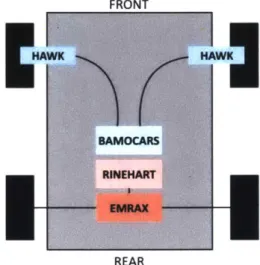

![Table 1: Flowrate, water temperature and pressure limit requirements of the Rinehart, Emrax, Bamocar and Hawk 40 motors as specified by their respective manufacturers [1],[2],[3],[4]](https://thumb-eu.123doks.com/thumbv2/123doknet/14684287.559904/9.917.77.795.289.416/flowrate-temperature-pressure-requirements-rinehart-specified-respective-manufacturers.webp)
